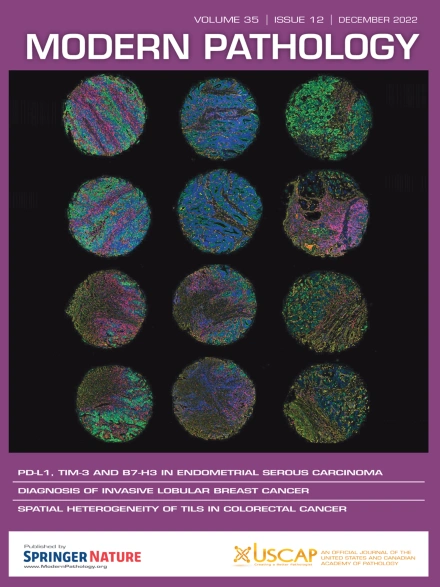Malignant Transformation in Pleomorphic Adenoma: The Impact of DNA Methylation Profiling and Pathogenic Mutations
IF 5.5
1区 医学
Q1 PATHOLOGY
引用次数: 0
Abstract
Salivary gland tumors are a rare and heterogeneous group of lesions with diverse microscopic appearances and variable clinical behavior. The most common salivary gland tumor subtype, pleomorphic adenoma (PA), can undergo malignant transformation into carcinoma ex pleomorphic adenoma (CXPA). Carcinomatous transformation from PA to CXPA is a highly progressive and multistep process. Distinguishing a PA with some atypia from a low-grade intracapsular or minimally invasive CXPA is primarily subjective as no mitotic count thresholds exist to help pathologists distinguish between them in difficult cases. In this prospective study, we collected 140 cases encompassing both PA and CXPA to study their molecular signatures. The primary objective was to investigate the use of DNA methylation profiling as a potential molecular tool for differentiating between these 2 entities. Methylation analysis was performed on 33 PA cases and 33 CXPA cases. We were able to demonstrate that based on their methylation profiles, PA and CXPA could be classified into 3 distinct clusters that we called benign, intermediate, and malignant. We also revealed that the presence of TP53, HRAS, PTEN, and/or TERT pathogenic mutations were exclusively present in CXPA cases and that chromosomal alteration on chromosomes 5 and 8 are potentially associated with malignant transformation. In conclusion, our study provides a comprehensive molecular framework for PA and CXPA. The presence of a pathogenic mutation in TP53, HRAS, PTEN, or pTERT or HER2 amplification could be integrated into a molecular diagnosis of CXPA for tumors within the PA–CXPA spectrum. In the future, we aim to improve our methylomic classification to make it a precision medicine diagnostic tool for the treatment management of tumors within the PA–CXPA spectrum.
多形性腺瘤的恶性转化:DNA甲基化谱和致病突变的影响。
唾液腺肿瘤(sgt)是一种罕见且异质性的病变,具有不同的显微镜外观和不同的临床行为。最常见的SGT亚型,多形性腺瘤(PA),可恶性转化为癌外多形性腺瘤(CXPA)。从PA到CXPA的癌变是一个高度渐进和多步骤的过程。区分非典型性PA与低级别囊内或微创性CXPA主要是主观的,因为没有有丝分裂计数阈值来帮助病理学家在困难的病例中区分它们。在这项前瞻性研究中,我们收集了140例包括PA和CXPA的病例来研究它们的分子特征。主要目的是研究DNA甲基化谱作为区分这两种实体的潜在分子工具的使用。对33例PA和33例CXPA进行甲基化分析。我们能够证明,基于它们的甲基化谱,PA和CXPA可以分为三个不同的集群,我们称之为良性,中间和恶性。我们还发现,TP53、HRAS、PTEN和/或TERT致病性突变只存在于expa病例中;5号和8号染色体上的染色体改变可能与恶性转化有关。总之,我们的研究为PA和CXPA提供了一个全面的分子框架。存在TP53、HRAS、PTEN、或pTERT或HER2扩增的致病性突变可以整合到PA CXPA谱内肿瘤的CXPA分子诊断中。在未来,我们的目标是改进我们的甲基组学分类,使其成为PA-CXPA谱内肿瘤治疗管理的精准医学诊断工具。
本文章由计算机程序翻译,如有差异,请以英文原文为准。
求助全文
约1分钟内获得全文
求助全文
来源期刊

Modern Pathology
医学-病理学
CiteScore
14.30
自引率
2.70%
发文量
174
审稿时长
18 days
期刊介绍:
Modern Pathology, an international journal under the ownership of The United States & Canadian Academy of Pathology (USCAP), serves as an authoritative platform for publishing top-tier clinical and translational research studies in pathology.
Original manuscripts are the primary focus of Modern Pathology, complemented by impactful editorials, reviews, and practice guidelines covering all facets of precision diagnostics in human pathology. The journal's scope includes advancements in molecular diagnostics and genomic classifications of diseases, breakthroughs in immune-oncology, computational science, applied bioinformatics, and digital pathology.
 求助内容:
求助内容: 应助结果提醒方式:
应助结果提醒方式:


